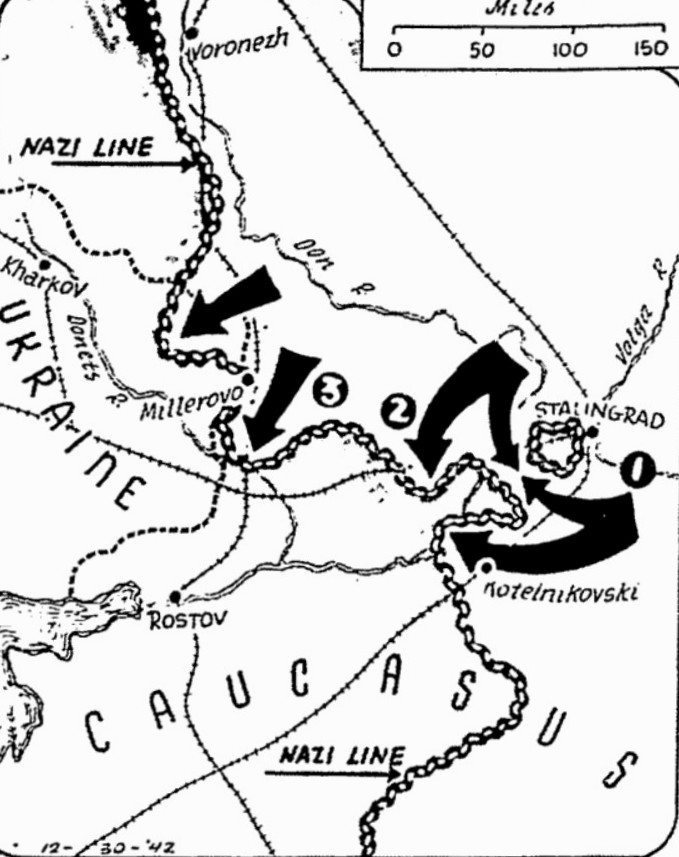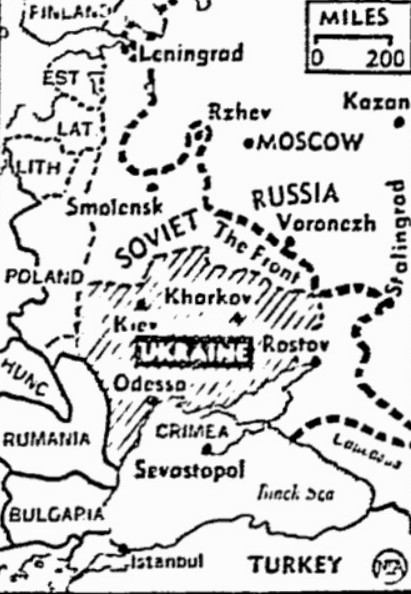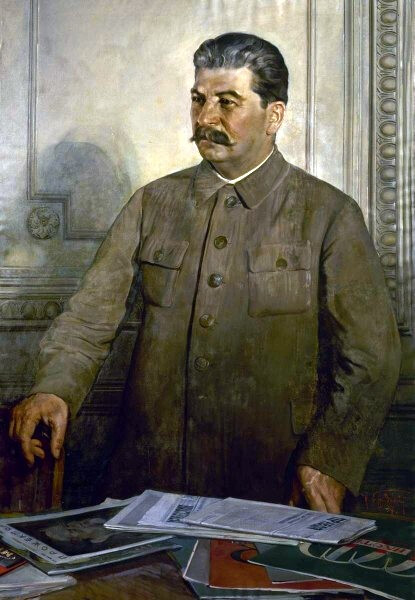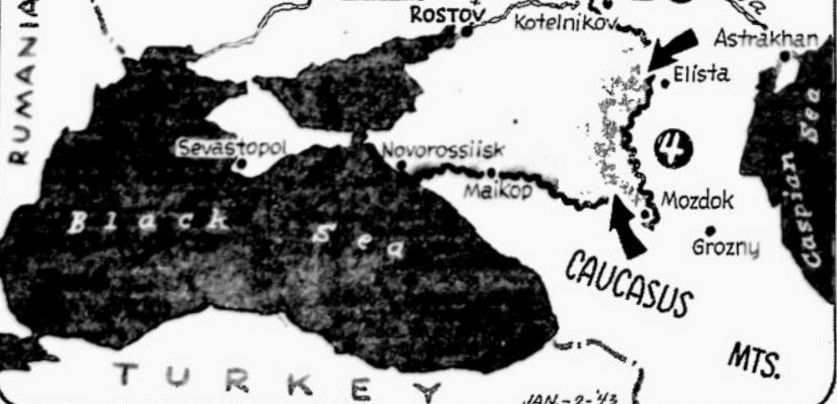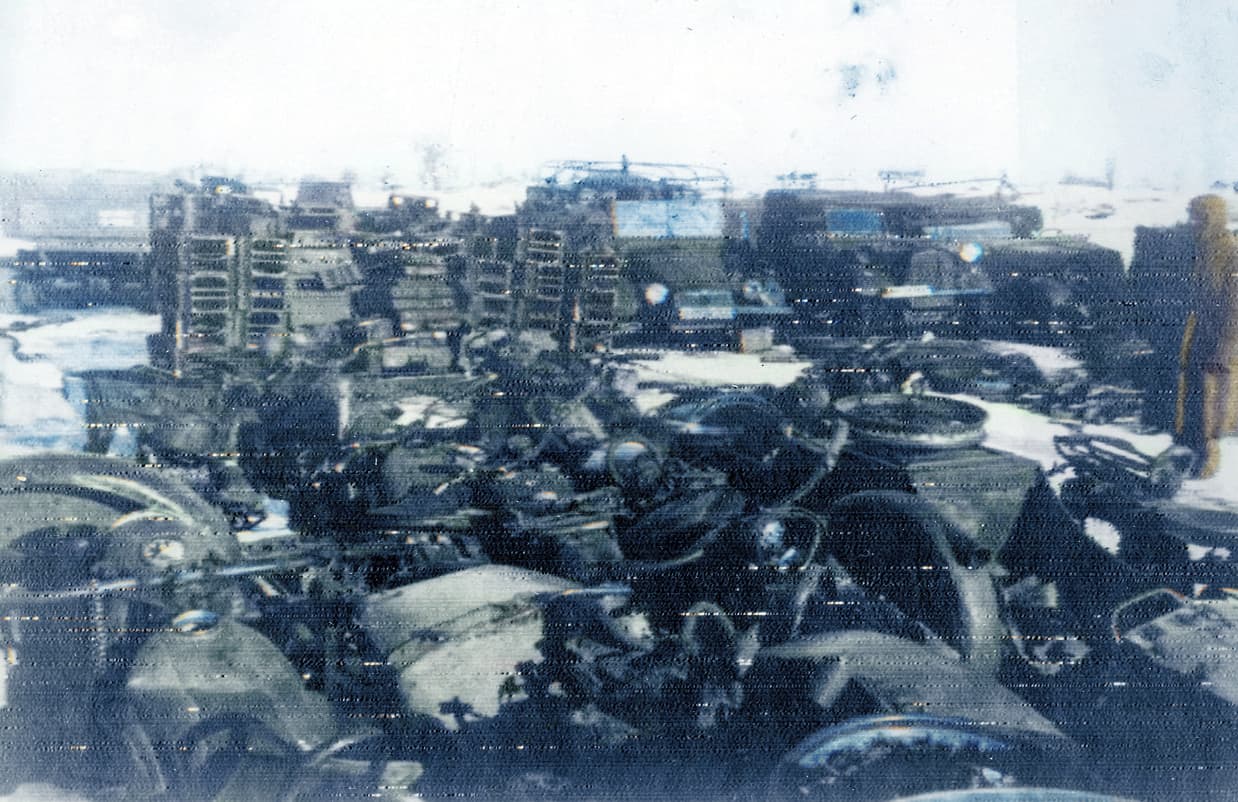The Evening Star (January 1, 1943)
Reds drive 40 miles past Elista
German toll in Russian push is put at 312,650
By Henry C. Cassidy, Associated Press war correspondent
Moscow, USSR –
Leaving the Kalmyk capital of Elista far in its rear, the Red Army has driven to the shores of the great lake east of Salsk in an offensive aimed directly at the Caucasus after trapping 22 divisions at Stalingrad and killing or capturing 312,650 of the enemy, the Russians reported today.
The rush to the shores of the great lake, now frozen and covered with snow, carried the Russian troops to a point about 40 miles southwest of Elista in the biggest single day’s jump of the offensive below Stalingrad.
The Russian winter campaigns thus had put the Germans forces in the Caucasus in an increasingly dangerous position after building a wall 37 miles thick at its narrowest point around the 22 German divisions trapped at Stalingrad.
The advance point reached yesterday, a Soviet communiqué disclosed, was Priyutnoe, about 40 miles south of Remontnoe, which was taken the previous day.
Garrison virtually encircled
The German garrison at Elista was virtually encircled, with the Russians having passed by both on the south and the north.
The lake spreads northwest to the approaches of Salsk, only about 90 miles away, and its frozen surface, it was believed, would facilitate the Russians advance at this season.
Salsk is a key point of the railway system south of the Don. It is on the Stalingrad-Tikhoretsk railway and a junction point for a connecting line to Rostov. Consequently, it was of importance in maintaining the connection between the Germans in the Caucasus and in the Ukraine.
Twenty miles south of Priyutnoe is Divnoe, the starting point of another railway linked with the Rostov-Baku trunk line. An advance along that line would threaten isolation of the German forces buried deep in the Mozdok and Nalchik sectors of the Caucasus.
Another dangerous bend had been created for the Germans farther north along the Don, where their flanks were menaced by two Red Army salients southwest of Stalin grad through Kotelnikovsky and west of Stalingrad to the Millerovo area.
The Germans still held the latter town, but the railroad leading southwest to Voroshilovgrad had been cut.
The two Russian arms thus threatened a second vast encirclement of German forces in the Don bulge.
Present frontline
The present frontline, as traced on maps published by morning newspapers along with a New Year special communiqué, was as follows:
Starting on the Don at Novaya Kalitva, 22 miles southeast of Rossosh below Voronezh, it ran south west through Markovka, then south of Voloshino, 20 miles southwest of Millerovo.
The line made a sharp bend northeast around Millerovo and back to the southwest to Verkhne Tarasovka, 15 miles south of Millerovo.
A series of curves then led southeast to Tatsinskaya, on the Stalingrad-Likhaya railway, east to Cherishkovsky, then south across the Don to the Stalingrad-Tikhoretsk railroad just east of Dubovskoye, then southeast toward the salient past Elista.
The special New Year communiqué said 1,589 towns had been captured in the powerful triple offensive on both sides of Stalingrad, in the middle Don and southwest of Stalingrad which began Nov. 19. Advances up to 125 miles had been chalked up, it said.
The special bulletin disclosed that the Red Army drives northwest and southwest of Stalingrad, through the middle Don area, and far south of Stalingrad were three closely-knit phases of one major strategic operation, carefully drawn up by the Red Army Command to save Stalingrad.
The communiqué declared:
The aim was skillfully accomplished.
It revealed that the Soviet drives went into high gear Dec. 12 and imputed bad planning to the German High Command.
The special victory recapitulation recounted:
In the course of September 1942, the German Fascist troops were halted by the Red Army before Stalingrad.
The war’s trend disclosed that the German strategic plans to capture Stalingrad and to cut off the central European part of the Soviets from the Volga and the Urals was hurriedly formed without taking into account their actual resources and the Soviet reserves.
In complete contrast was the Soviet’s strategic plan for surrounding and defeating the German troops at Stalingrad, drawn up by the Supreme Command of the Red Army. This plan was carried out in November and December 1942.
Twenty-seven Russian commanders were cited specifically in the communiqué for their leadership among infantry, tank and plane forces, under the general leadership of Gen. Gregory K. Zhukov. Commanders principally singled out were Col. Gen. N. F. Vatutin, Lt. Gen. Constantin Rokossovsky, Lt. Gen. F. I. Golikov, Col. Gen. Yeremenko, Col. Gen. Vissilevsky and Col. Gen. Voronov.
Claim Nazi entrapment
For the first time, Soviet authorities claimed officially that the 22 German divisions before Stalingrad – some of the Nazi troops still hold dugouts in the factory area of the Volga River port – were tightly encircled.
And for the first time, Col. Gen. Yeremenko was named as the defense commander of the city which went under siege 131 days ago today.
Gen. Yeremenko was not listed in available American directories and his name has not figured in Soviet strategy reports before.
The regular communiqué of the Soviet Command, issued early today following the special announcement, said the drives continued yesterday on all fronts. It reported the capture of Oblivskaya, a city on the Chir River in the Lower Don, 90 miles west of Stalingrad and 100 miles southeast of Millerovo. A trainload of airplanes was reported taken at Oblivskaya.
The capture of the district centers of Nizhne Chirskaya, about 65 miles southeast of Stalingrad on the west bank of the Don near its junction with the Chir River, and of Pritnaya was also announced.
Priyutnoe – a variable spelling – is shown on available maps 40 miles slightly southwest of Elista and 40 miles south of Remontnoe to which the Russians had driven Tuesday. The extent of the advance indicates the speed with which the Red Army was moved into the Kalmyk Steppe. The town is only about 10 miles from the waters of the Manych River.
Offensive continues
The third communiqué of New Year’s Day, the Soviet Information Bureau’s midday bulletin, said the Russian offensive continued to roll in last night’s fighting, with the capture of several more populated places southwest of Stalingrad and three more towns in the middle Don.
German counterattacks remained bitter, the bulletin said, but futile.
It described the success of a Russian tank outfit southwest of Stalingrad in destroying 300 Germans along with their equipment.
It reported:
In another sector, Germans who had fortified themselves in their positions attempted to halt the advance of a Soviet unit. Our troops by-passed the enemy and then attacked him from the rear. In fierce engagements, 400 enemy officers and men were killed and war material and prisoners were captured.
The advance, which swept three more towns into the Russian fold in the Middle Don, also netted 450 prisoners and equipment, the communiqué said.
Marked for annihilation
In the Velikiye Luki area, the Russians said encircled Axis garrisons were marked for annihilation. In the region west of Rzhev, Red Army units were dislodging Germans from strongpoints, the Soviet report said.
The Germans have admitted that Velikiye Luki is surrounded by the Russians.
The special war summary disclosed in detail the plans to save Stalingrad, which is named for Premier Joseph Stalin and which survived bitter pounding blows after Stalin himself addressed a plea to the Russian people to hold the city.
The communiqué listed the capture of 213 populated places in advances of 43-93 miles in the first operation. Here 95,000 enemy troops were reported killed, 72.400 captured, 134 planes captured and 286 destroyed, 1,792 tanks captured and 548 destroyed, 7,306 trucks captured and 3,190 destroyed, and 2,232 guns captured and 934 destroyed.
In the second – the middle Don – operation, a total of 1,246 towns and village was captured, the Russians said, in advances ranging from 93 to 125 miles. The Axis dead were listed at 59,000 and captured at 60,050. The Russians counted as captured and destroyed 485 planes, 340 tanks, 8,414 trucks and 2,197 guns.
62-to-93-mile advances
In the third operation south of Stalingrad, advances of 62-93 miles swept in to 130 towns, killed 21,000 Germans, and captured 5,200, the communiqué said. It listed as captured and destroyed 346 planes, 561 tanks, 549 guns and 1,274 trucks.
The communiqué was specific in listing by division numbers the 36 German and Romanian divisions reported routed, including six tank divisions, and the seven others which it said suffered heavy losses.
A recording of the broadcast communiqué in London contained the phrase “The German Army in Stalingrad is liquidated completely,” but fuller versions of the text, available later, did not bear this out.
In the recapitulation of materiel, ordnance and war goods taken or destroyed during the advances, the special war bulletin noted 137,850 rifles, more than 5,000,000 shells, more than 50 million rounds of ammunition, 2,120 railway trucks, 46 locomotives, 15,783 horses and 3,221 motorcycles.
